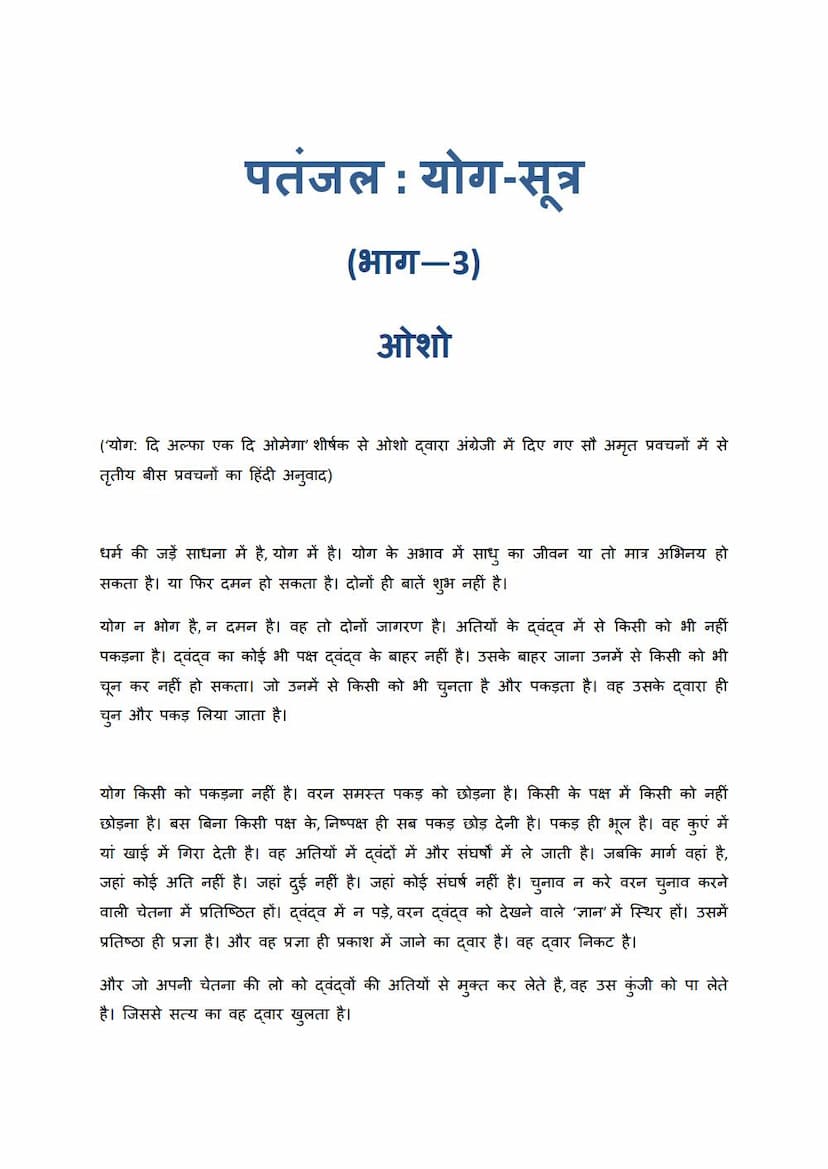Patanjali Yoga Sutra Part 03
Added to library: September 2, 2025

Summary
This text is a Hindi translation of Osho's discourses on Patanjali's Yoga Sutras, compiled in "Patanjali Yoga Sutra Part 03." The summary below focuses on the key themes and concepts discussed in the provided excerpt:
Core Message: The Nature of Reality, Self, and the Path to Liberation
Osho's commentary emphasizes that true spiritual progress (Yoga) is not about external practices or adhering to strict rules, but about an inner awakening and the shedding of all attachments and identifications. The path is not about choosing one extreme over another, but about transcending the dualities of life.
Key Concepts Discussed:
- The Nature of the Visible (Drishya): The world of phenomena, composed of natural elements and senses, is characterized by illumination (clarity/steadiness), activity, and inactivity. It exists solely for the experience and eventual liberation of the seer (Drashta). The visible world changes based on the observer, and the observer also changes based on the observed.
- The Seer (Drashta) and Ignorance (Avidya): The seer, though pure consciousness, perceives through the distortions of the mind. The root cause of this mistaken perception and the subsequent suffering is Avidya (ignorance). True knowledge is not impersonal; it is inherently personal and requires participation.
- The Distinction Between Science, Art, and Religion: Science is characterized by non-participation, art by partial participation, and religion by total participation and merging. However, Osho notes that modern science is increasingly acknowledging the interconnectedness and participatory nature of observation, blurring the lines.
- The Purpose of Existence: The world exists to facilitate the seer's experience and ultimately, liberation. Pain and suffering are seen as a crucible for purification and growth, a necessary training for spiritual maturity.
- Beyond Duality and Extremes: The path of Yoga lies in transcending extremes and dualities. Choosing any side of a duality, or clinging to any belief system, keeps one trapped in the cycle of conflict. True wisdom lies in understanding the duality without being caught by it.
- The Nature of Knowledge: True knowledge is not accumulation of information but an inner realization, an experience. It cannot be borrowed; it must be lived. External theories and doctrines are merely borrowed clothes; true understanding is an inner unfolding.
- The Importance of Awareness and Presence: The key to liberation is not to control or suppress, but to be aware and present. By living with consciousness, one transcends suffering.
- Yoga as Integration and Union: Yoga is ultimately about union – the union of the knower and the known, the merging of all divisions and limitations. It is the journey back to one's true nature.
- The Three Gunas (Sattva, Rajas, Tamas): Osho explains the three fundamental qualities that constitute the universe and how Yoga aims to balance them. He draws parallels with modern physics' understanding of subatomic particles.
- The Four States of the Gunas: The text describes the four states of the gunas as determined (material), undetermined (mind), symbolic (soul), and unmanifest (beyond ego/self). These represent stages of manifestation and consciousness.
- The Illusion of Separation: The feeling of separation, the division into 'I' and 'other,' is an illusion rooted in ignorance. True realization leads to the dissolution of these boundaries.
- The Path of Transformation, Not Suppression: Osho strongly advocates for transforming desires and emotions rather than suppressing them. Suppression leads to further bondage, while understanding and transformation lead to freedom.
- The Nature of the "Self": The true self is beyond the body, mind, and emotions. It is the pure witness, the aware consciousness, which is never created, never destroyed, and is the ultimate reality.
- The Role of the Master: The Guru or Master is not a creator but a catalyst. Their presence can awaken the disciple, but the journey and the realization are ultimately individual.
- The Nature of Suffering: Suffering arises from clinging to the ego, to personal desires, and to the illusion of separateness. True liberation comes from understanding the nature of suffering and transcending the ego.
- The Essence of Religion as Participation: True religion is not about dogma or rituals but about total participation and merging with existence. It is about experiencing life in its totality, leading to ultimate liberation and joy.
- The Seven Stages of Enlightenment (Sambodhi): The text briefly mentions that the ultimate state of enlightenment is achieved in seven stages, hinting at a gradual but profound unfolding.
Osho's Perspective:
Osho's commentary brings a contemporary and often provocative interpretation to Patanjali's ancient wisdom. He emphasizes the direct, experiential nature of spiritual realization, critiquing rote learning and intellectual understanding as insufficient. He encourages an active, conscious engagement with life, seeing all experiences, even seemingly negative ones, as potential stepping stones on the spiritual path. His discourses are marked by clarity, insight, and a characteristic blend of humor and profound wisdom.
This summary aims to capture the essence of the provided text, highlighting the central ideas that Osho conveys in his commentary on the Yoga Sutras.